St. Clement was not always a eucharistic shrine, or even a Catholic church. There is a long history behind Boston’s beloved Shrine and how it came to be as it is today.
Early History (1925-1935)
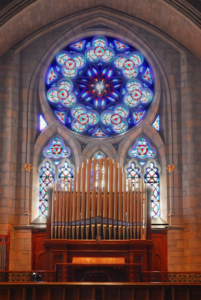
The church structure was built by the Second Universalist Society of Boston in 1925. At a cost of $800,000, they built one of the finest reproductions of early Gothic architecture in the United States. (Adjusted for inflation, that is $11.4 million in 2017). The complex contained a large church, a smaller chapel, and meeting rooms. The new church was named Church of the Redemption, but many referred to it as “The Church Beautiful.” One early observer commented, “The interior of the church, with its delicate tracery windows of leaded art glass, its lofty columns, groined arches and deep chancel with the altar table and illuminated cross above, creates an atmosphere of worship and reverence. To enter the church with others on Sunday or alone on a weekday is to feel the presence of the Eternal.”
Despite its beauty and grandeur, the church had massive financial burdens and dwindling support. After the economic crash of 1929 and a significant loss of Universalist congregants, the century-old Second Universalist Society merged with Arlington Street Church. In 1935, only ten years after construction, the Church of the Redemption was put up for sale.
St. Clement Chapel (1935-1944)
William Cardinal O’Connell, the Archbishop of Boston, sensed a historic opportunity and bought the church. On December 8, 1935, the church was dedicated to St. Clement in honor of the Cardinal’s titular church in Rome. St. Clement was used as an auxiliary chapel for St. Cecilia Parish, which had grown rapidly and was now able to offer more Sunday Masses at the additional location. Either Fr. Francis Moran or Fr. John Sexton, who both worked full-time for the archdiocesan newspaper, The Pilot, and lived at the St. Cecilia rectory, usually celebrated the daily 8 a.m. Mass at St. Clement.
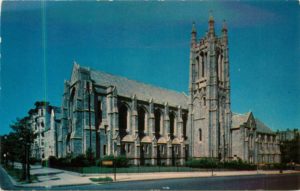
St. Clement Eucharistic Shrine (1944- )
On September 25, 1944, Archbishop Richard Cushing became primate of Boston. He wanted to found a eucharistic shrine in the archdiocese, and St. Clement was available because it was no longer urgently needed by St. Cecilia Parish. The Archbishop asked the Franciscan Missionaries of Mary, whose charism included strong eucharistic devotion, to take custody of St. Clement. With the approval of their Mother General, the Sisters agreed. On May 3, 1945, Archbishop Cushing officiated at the inauguration of Boston’s new eucharistic shrine.
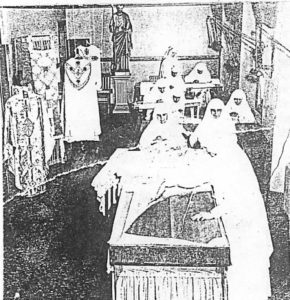
From May 3 on, two Sisters knelt in silent adoration before the Eucharist at every hour of the day. A large grille separated the semi-cloistered Sisters from the rest of the church. The former meeting rooms and side chapel became the living quarters for two dozen Sisters. To provide income, they made vestments and religious cards and earned a reputation throughout New England for fine embroidery.
St. Clement’s Convent soon became a residence for student Sisters. These were mainly newly professed Sisters or those recently returned from the missions who pursued graduate studies at institutions such as Emmanuel College, Boston College, or Newton College of the Sacred Heart. The convent was expanded in 1953 with the addition of two wings adjoining the church structure.
It is difficult to overstate the role that St. Clement Eucharistic Shrine came to play in the Archdiocese of Boston. The syndicated Catholic journalist, Fr. Daniel Lord, SJ, wrote in 1953 that the Archdiocese of Boston seemed to “center on its eucharistic shrine.” The credit for this goes to the efforts of Archbishop Richard Cushing: many referred to St. Clement as “his” church. Cardinal O’Connell had dedicated St. Clement, but Cardinal Cushing made it the eucharistic shrine and spiritual center it has continued to be in the heart of Boston.
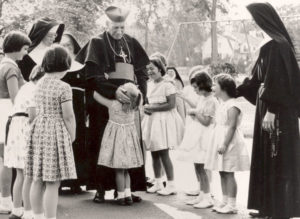
Nocturnal Adoration Society (1945-1960s)
To spread the apostolate and share the benefits of eucharistic devotion, the archdiocese began a Nocturnal Adoration Society of Catholic laymen who volunteered to spend one hour a month in adoration at the Shrine. This practice had begun in Rome 160 years before and had since become a worldwide society. Men came every Friday and Wednesday night from 9 p.m. to 7 a.m. for adoration before the Blessed Sacrament. At the ceremony for the consecration of the Nocturnal Adorers, on December 8, 1945, Archbishop Cushing said, “You are the great army of an offended God, for, while others are enjoying nocturnal pleasure, you are kneeling in adoration, reparation, and petition before the throne of the Eucharistic King.” In December 1945, there were 576 men in the Nocturnal Adoration Society. They came from parishes all over the diocese, such as St. Ann in Neponset, St. Angela in Mattapan, St. Columbkille in Brighton, and St. Polycarp in Somerville. By January 22, 1949, there were 2,600 members in the Society.
Transition Years (1963-1976)
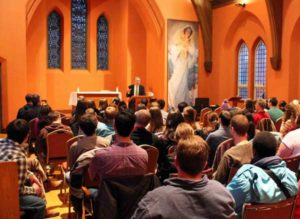
The 1960s were a time of many changes in the Church and the world. The construction of the Massachusetts Turnpike in the 1950s changed Boston’s Back Bay profoundly, including the parish boundaries. St. Clement Shrine became a center of student ministry due to its position between burgeoning college campuses. The Shrine was transformed from a silent adoration chapel to a crowded student center with Sunday Masses that were often standing-room only. This brought new liveliness, but also dramatically changed the traditional rhythm of prayer and liturgy practiced by the Franciscan Sisters. From the very beginning the priests implemented all the liturgical changes allowed by the diocese, including lay lectors, congregational singing, folk music, the sign of peace, and Communion under both species.
The Franciscan Missionaries of Mary decided to withdraw from St. Clement in 1966. In 1970, the Newman Center, which now occupied the offices and meeting rooms adjacent to the Church, changed its name to St. Clement Student Parish. Although not canonically a parish, it took on many functions of a parish: baptisms, weddings, convert instructions (precursor to RCIA), Pre-Cana, parish council, etc. A newsletter-style bulletin was begun to connect with the hundreds of people coming to Sunday Masses.
Oblates of the Virgin Mary (1976- )
After the Franciscan Missionaries of Mary departed, many different ministries used the Shrine. The new Archbishop of Boston, Humberto Cardinal Medeiros, began searching for a new religious order to staff the Shrine and bring a unified vision to ministry. He invited the Oblates of the Virgin Mary, a small order of priests and brothers from Italy.
In 1976, Fr. Vincenzo Antolini was the first Oblate priest to arrive in Boston. Working patiently for many years, he gradually brought the Shrine and its ministries under the administrative oversight of the Oblates. He was joined by several young American priests and brothers who had studied in Italy and were sent to the new foundation in their native country. Fr. David Beauregard, Br. Luigi Falbo, Fr. Timothy Gallagher, and their Canadian confrere Fr. Ernest Sherstone were some of those early Oblates.
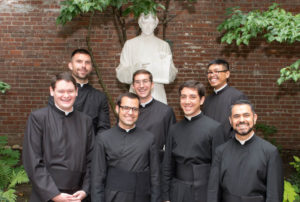
The many American vocations that provided Oblate priests for the community in Boston continued, and the Oblates discerned the need for a house of formation in the United States. Our Lady of Grace Seminary was opened at St. Clement in 1978. Our Lady of Grace continues to be the house of formation for Oblate seminarians from all over North America and currently includes the postulancy, novitiate, and theologate of St. Ignatius Province.
Recent Years (1990- )
In the early 1990s, the Oblates began a new chapter in the history of St. Clement with serious restoration work at the Shrine. Now 70 years of age, the church facility was in need of major structural as well as cosmetic work. Nearly a century after construction, the restoration work is almost complete with the recent repair of the façade and finished window restoration.
As the early structural work was completed in the late 1990s, the Oblates decided to reopen St. Clement to the people of Boston: after serving as the seminary chapel for 20 years, St. Clement began an adoration society of men and women who came to spend time in prayer before the Lord every afternoon. The adoration extended from the midday Mass until Benediction at 9 p.m.
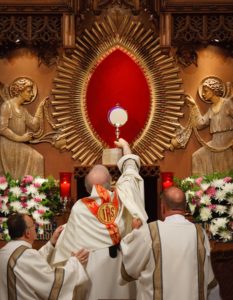
Perpetual Adoration returned to St. Clement on the Solemnity of the Assumption, August 15, 2008. Seán Cardinal O’Malley celebrated Mass and Exposition, and since then adoration has continued without interruption 24 hours a day, every day.
St. Clement Eucharistic Shrine remains a spiritual powerhouse in the Archdiocese of Boston, as envisioned by Cardinal Cushing. Mass, Confessions, spiritual direction, young adult groups, and ministries of healing bring people together here, but above all adoration of the Lord in the Blessed Sacrament for those seeking a place of prayer, recollection, and healing.

